We reached out to our friends and fellow bloggers and asked them to share their best hometown and local cuisine eats. Sharing their generosity, here’s the inside scoop on where to eat in two dozen locales!
This post may contain affiliate links which means that we receive a small commission if you click on a link & purchase something that we’ve recommended – at no extra cost to you. This helps us to keep our site running so we can continue to provide free content.
Tacos al Pastor – Mexico City
If there’s one word synonymous with Mexico — it’s tacos! While there are many varieties of tacos, from the barbacoa (barbecue) tacos of Hidalgo state, to the fried fish tacos of Baja California, Mexico’s most universally beloved taco is the taco al pastor.
Arepa Paisa, Antioquia Colombia
Recommended by Daniel James, Layer Culture
Living in Colombia or arriving here as a visitor you will find that the Arepa is a universal food sold in most food establishments. The Arepa Paisa though has a unique difference when comparing to other Arepas in Latin America. Firstly, the Arepa Paisa is unique to the Antioquia region and is often eaten for breakfast, lunch, and dinner. The Arepa is so versatile it can be eaten with more or less anything, and makes the perfect vessel for other foods. Most Colombian food that you see whilst in Medellin and the surrounding towns and villages of Antioquia will have an Arepa served with it. The Arepa can be found at most street food stands and almost always comes as part of any meal that you may order in a restaurant – especially during lunchtime. Because of its unique ingredient (threshed corn), it can be hard to find outside of Colombia but there are many variations of this versatile flatbread that you can try at any authentic Colombian restaurant around the world.
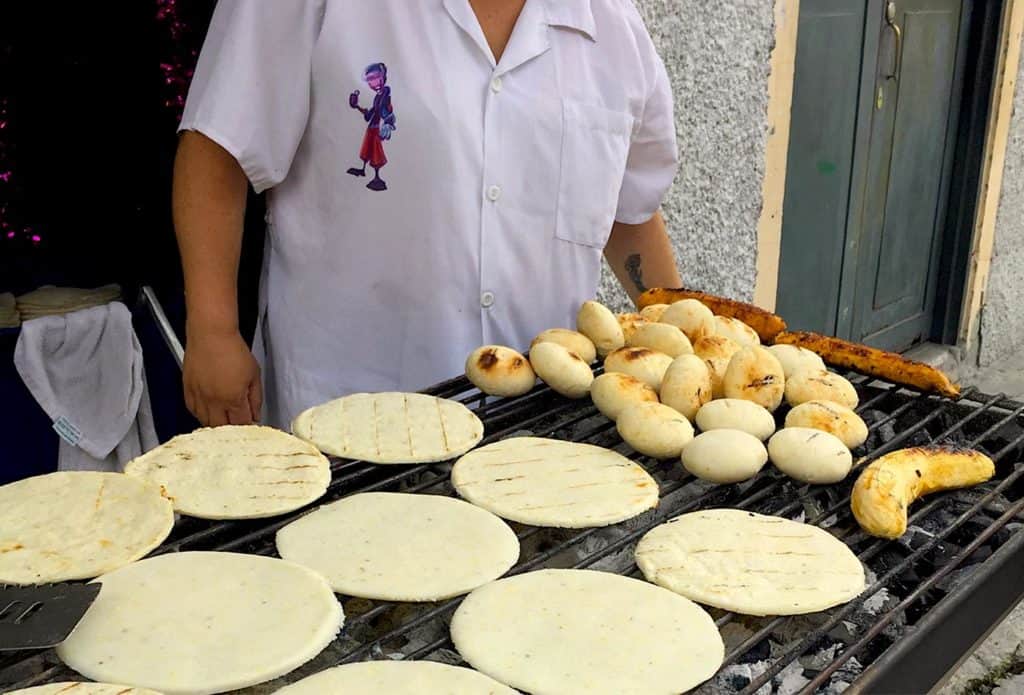
Ropa Vieja, Cuba
Recommended by Carley Rojas Avila of Home to Havana
Ropa vieja is a savory shredded beef dish, one of Cuba’s national dish and a favorite of Cuban cuisine – a must for anyone looking to travel to Cuba. Ropa vieja means “old clothes” in Spanish, which is a play on how the shredded flank steak or skirt steak that makes for the best ropa vieja looks like shredded rags when plated up. Originally created as a Spanish meat stew, this dish grew and took on life when brought to the Americas during colonization, where tomatoes, bell peppers, and sweet ají peppers from the Americas transformed it and made it richer and saucier than earlier versions.
Ropa vieja is a versatile main dish often served with white rice and traditional Cuban black beans, but can also be accompanied by fried plantains or sweet fried bananas, yuca with mojo dressing, and avocado. Part of the appeal of this dish is how well it works with the rest of the Cuban staples, including beans and rice, and any of the popular variations of plantains or bananas that are so constant through the Caribbean.
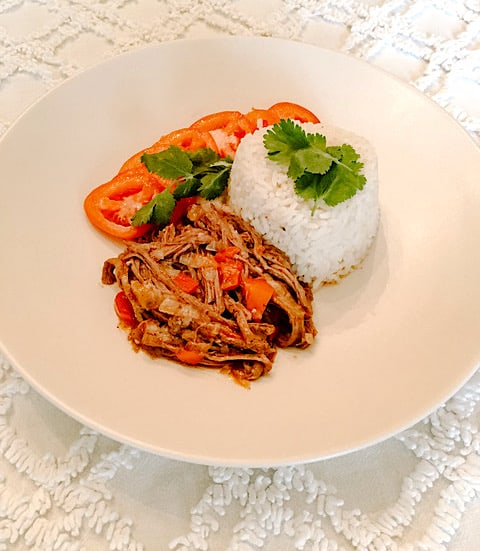
Arepa, Colombia
Recommended by Claudia Lizeth of Spanish Latin America
Arepas are made from ground maize dough. Depending on where you are you will come across arepas of varying colors, sizes, stuffing, and flavor.
You can have arepa any time of the day, although in lots of regions they eat it for breakfast usually. It can also be split to make sandwiches and stuff or top with chicken or any other type of meat, avocado, cheese, etc. Another popular way is to eat it with chorizo as well.
In Colombia and Venezuela, you can find arepas everywhere starting from street vendors to market plazas, and cafeterias. But to try the best arepas, I would suggest you try the restaurants in Medellin where they serve arepas in some of the most unique styles and stuffings of meat or egg.
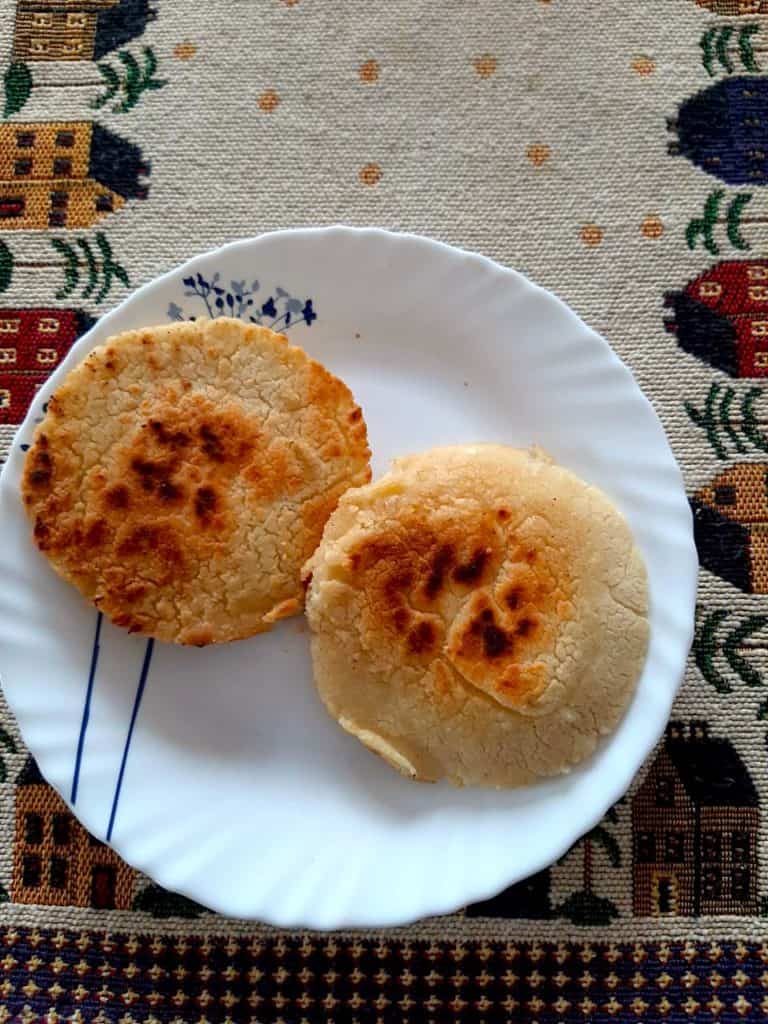
Cheesesteak, Philadelphia Pennsylvania USA
Recommended by Derek Hartman of Robe Trotting
Philadelphia is a city that’s rich with history and delicious foods. From regional specialties to high-end dining – there are so many great tastes in the city. Still, the most famous Philadelphia food is the world-famous cheesesteak.
The legend of the local sandwich cuisine dates back to 1930 when a hot dog vendor tossed beef onto his grill to make a sandwich. A local cab driver happened to be in line for a hot dog but asked for the same sandwich. He was impressed with the result and raved about it to those he picked up for the rest of the day. Soon, the hot dog stand had a following of Philadelphians asking for a hot diced beef sandwich. Eventually, another employee added cheese and other toppings and the result slowly evolved into the beloved sandwich that’s known the world over.
The key to a Philadelphia cheesesteak is a long roll (usually from Amoroso’s Bakery). It’s cut long ways and filled with diced beef that’s grilled with oil. Toppings include American, provolone, or swiss cheese, but many vendors also use cheese whiz sauce. Then toppings like onions, mushrooms, peppers, and sauce are added.
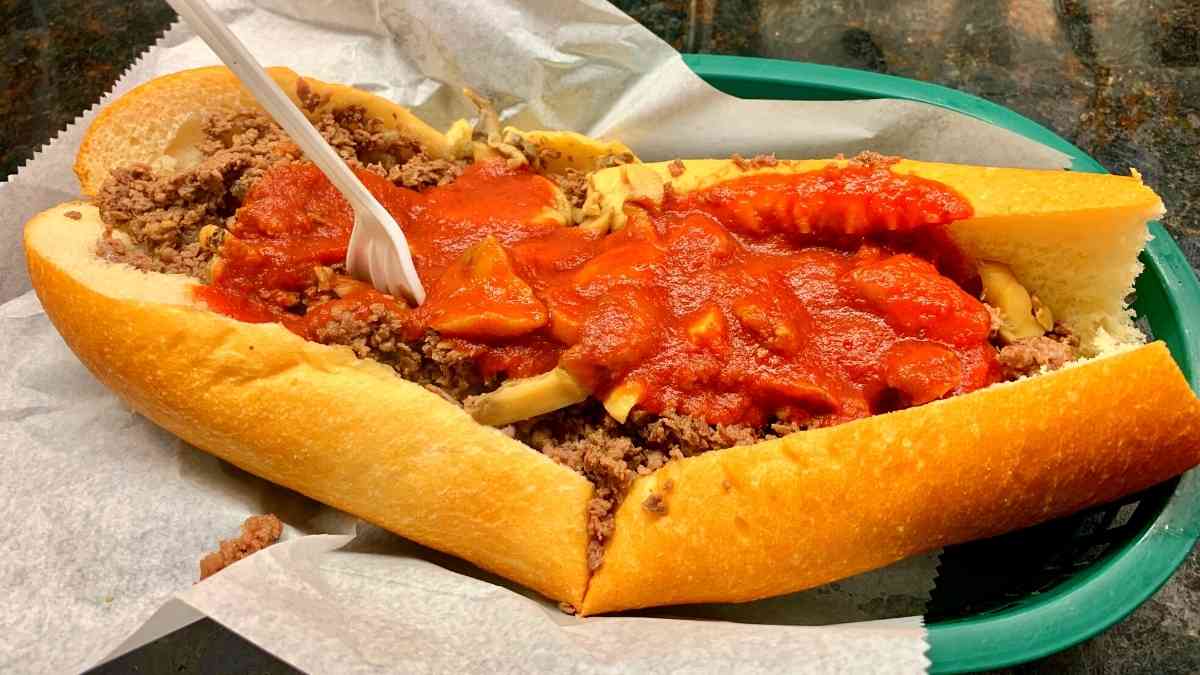
Malasadas, Hawaii USA
Recommended by Marcie Cheung of Hawaii Travel with Kids
One of the best things to eat in Hawaii for breakfast are malasadas. They look like oversized fluffy doughnut holes that are coated in sugar. Over the years, Hawaiian bakeries have experimented by filling them with custard and tropical fruit fillings (like mango, lilikoi, or coconut.) This local cuisine is originally from Portugal, but made their way to Hawaii where they have turned into one of the most popular breakfast pastries!
The most famous place to find Hawaiian malasadas is Leonard’s Bakery on Oahu. They have a brick and mortar store and food trucks around the island. People line up at the crack of dawn to get a box of their original or filled malasadas. Malasadas definitely taste better fresh and pair perfectly with a cup of coffee. But, you can reheat them in the toaster oven or microwave the next day. If you aren’t heading to Hawaii soon, you can make your own malasadas at home!

Shrimp and Grits, South Carolina USA
The South Carolina Lowcountry, an area from Charleston to the Savannah River, is known for shrimp and grits as it’s local cuisine. It’s a savory dish that is most often served for lunch or dinner. However, the history of shrimp and grits is rooted in the first meal of the day.
Before restaurants started featuring the dish on their menus, fishermen would often start their day with “breakfast shrimp.” The meal was easy to prepare – a large pot of grits and a few (easily caught) shrimp cooked with onion in bacon grease. However, like a lot of food in the coastal south, many believe the origins of shrimp and grits hail from Africa, specifically Mozambique, where local dishes historically combine corn and shellfish.
Today you can find a slightly more elaborate shrimp and grits on menus throughout much of the south. A roux like sauce with fresh shrimp, onions, and often ham, peppers, or whatever else the restaurant decides on, is spooned over a bowl of creamy grits.
The best variations use stoneground grits which are coarsely ground and cooked for at least an hour in a mixture of water and cream equal to four times the volume of the raw grits. The result is a salty, satisfying dish that brings out some of the best of the south, flavored by the sea.
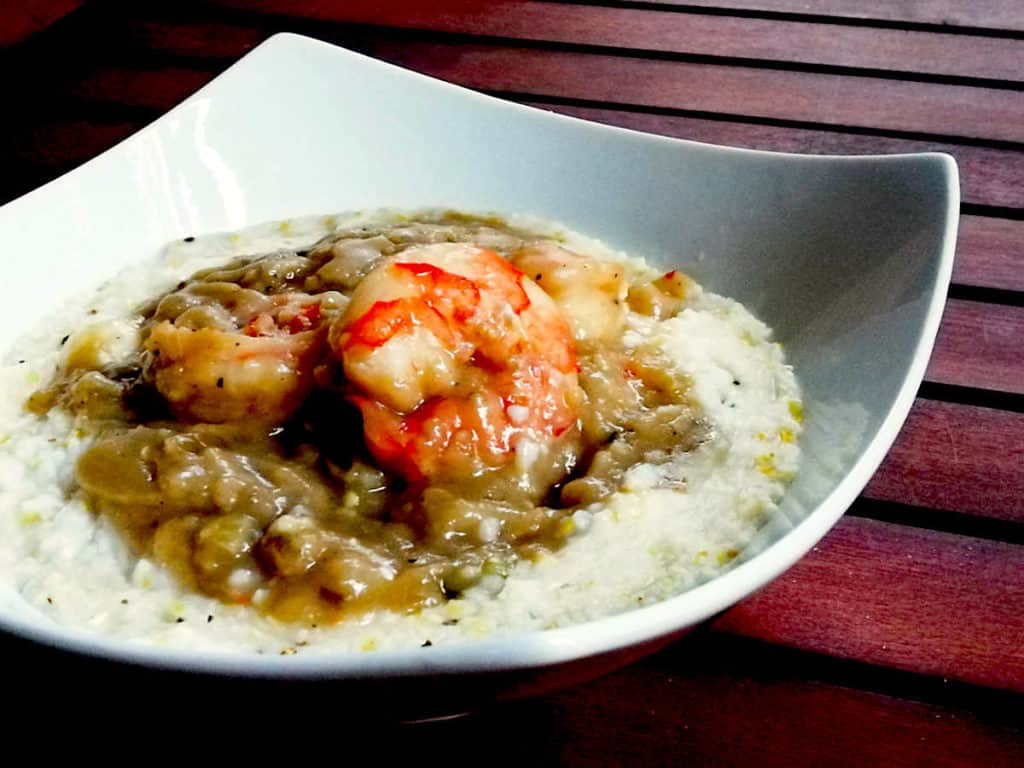
Apizza, New Haven Connecticut, USA
Recommended by Lyndsay Crescenti, The Purposely Lost
Apizza came from people immigrating to New Haven, Connecticut, from the Naples, Italy area, starting from the beginning of the 20th century. Its major stand-out differences from other pizza types include its thin crust, oval shape, and asymmetrical slices.
While there are a number of restaurants in New Haven that serve the style, the major pizzerias in New Haven are Sally’s Apizza, Modern Apizza, BAR, and Frank Pepe Pizzeria Napoletana, which originated the apizza style and is often highly ranked for the best pizza in the United States.
Pit Beef Baltimore Maryland, USA
Thinking about food in Baltimore conjures up images of steamed crabs, heavily seasoned with spice- and pepper-laden seasoning. What you may not realize is pit beef is what Baltimoreans (sometime called, self-dprecatingly, Baltimorons) consider our local prize. Pit beef is served year round, unlike crabs that are seasonal. Surprisngly, it’s a rather new, originating somewhere around the late 1960s early 1970s. Starting as a working class meal, pit beef has become everyone’s homtown favorite.
The pit beef sandwich starts with the top round cut, cooked over hot coals. It’s then sliced thin and piled on a kaiser roll (although some stands use potato rolls). Importantly, this is not Maryland’s answer to barbecue. Rather than being cooked slow and low by smoke, the meat is cooked over hot coals. You can ask for your meat cooked to your temperature preference; I always go for medium rare.
Locals will tell you that the only way to eat pit beef is with raw onions and Tiger Sauce, a blend of mayonnaise and horseradish. Some prefer barbecue sauce on the mound of beef. It is often served with another Baltimore specialty, gravy fries. Think poutine without the cheese curds. Most pit beef is served at small roadside stands, although the sandwich can be also found at the famous Orioles baseball stadium.
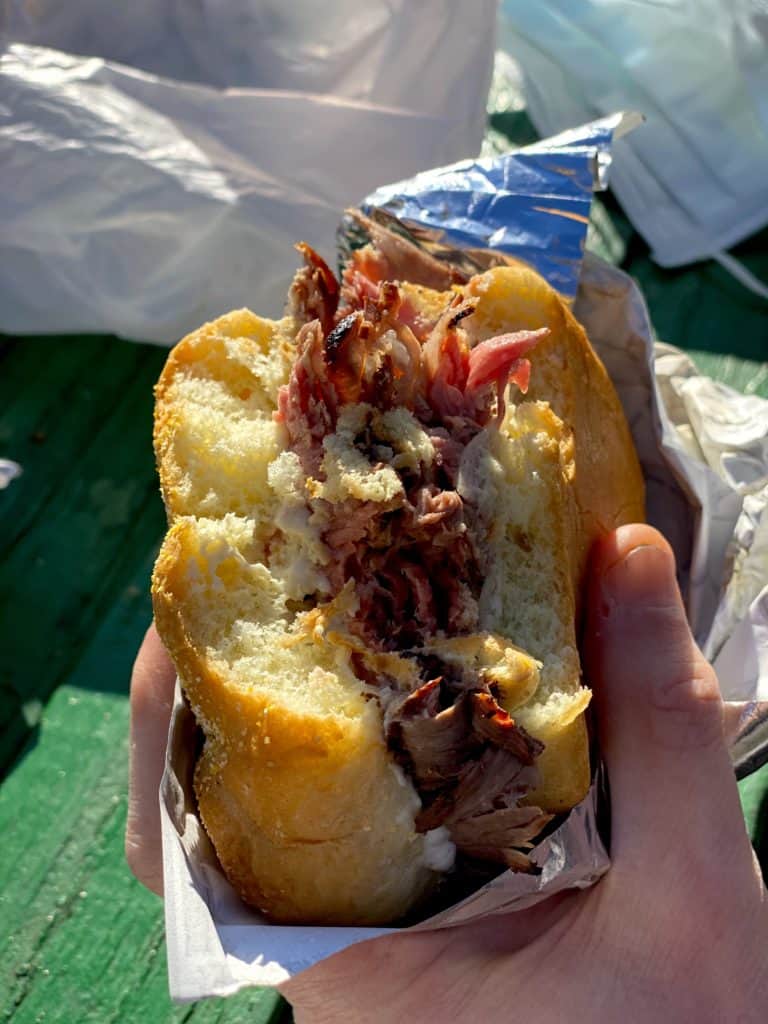
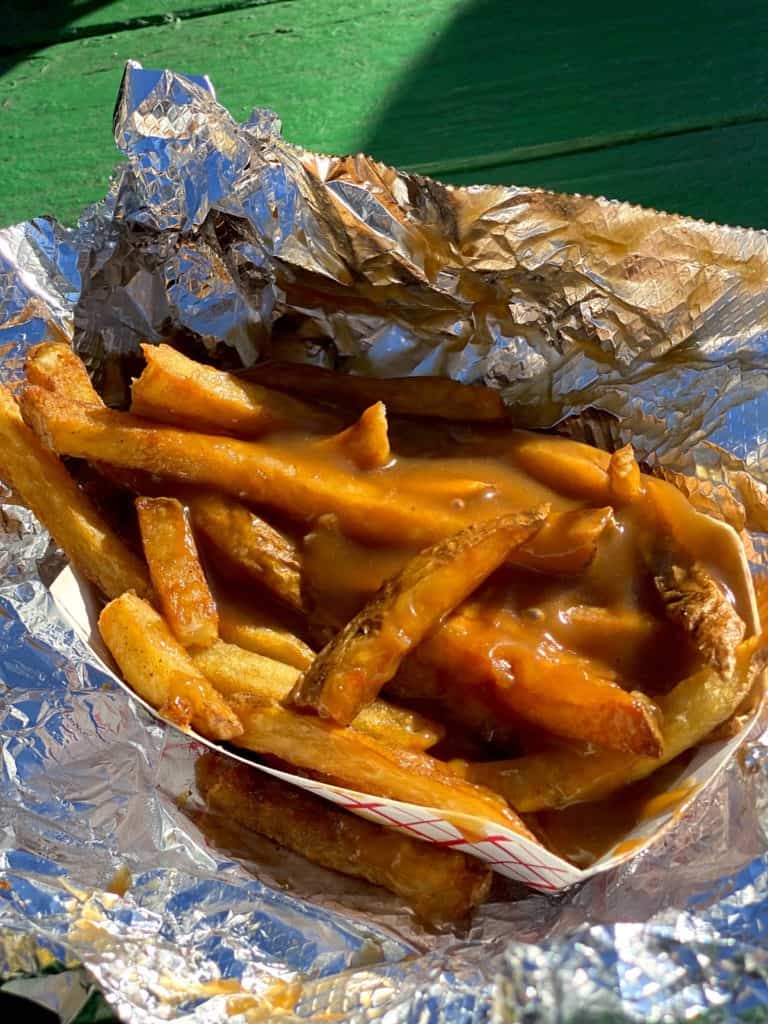
Poutine, Canada
Poutine originated in the province of Quebec in Canada in the early 1950s. Today, it is considered by Canadians as a national dish and can be found in almost every small town or large city in Canada.
Fish and chips, England
Recommended by Rose Munday, Where Goes Rose
Botifarra, Barcelona Spain
Recommended by Vicki Franz of Vicki Viaja
One thing is clear: Barcelona is the perfect destination for foodies from all over the world. Local cuisine, like tapas and paella, in particular, are among the city’s most popular dishes. While these are typical Spanish specialties, they are not typical of Barcelona.
Herring & Cheese, The Netherlands
Recommended by Frans van Dokkumburg, Ask the Dutch Guy
Although the Netherlands (or Holland) is a small country, it is packed with many famous icons in the world. From tulips to food, it is definitely rich in culture. Herring and cheese are two of the famous foods you should try while you’re here.
Herring is a popular food in the Netherlands; it’s a fatty fish that is rich in flavor and omega 3s that is good for you, which is why you should definitely NOT skip this popular dish when you are in the country. Don’t be fooled, though—there’s no such thing as eating the fish raw. Instead, it is brined, so you don’t have to worry about anything, especially if you’re iffy with raw fish (well, except for sushi and sashimi!). The herring you will find on the streets of the country is lightly cured in salt and it’s not fishy at all.
When you are in Amsterdam, it’s common to eat herring with toothpicks and in bite-size pieces with chopped onions and gherkins on the side. You can also have it in a sandwich, which is also known as the broodje haring.
While you’re at it, you should also try out the best cheese in the country, which is Gouda. When it comes to cheese production in the country, they are more devoted to the iconic cheese; however, they are also famous for Edam cheese here.
If you really want to try the best Dutch cheese, Gouda, semi-hard cheese with 48% milk fat content is something you shouldn’t skip.
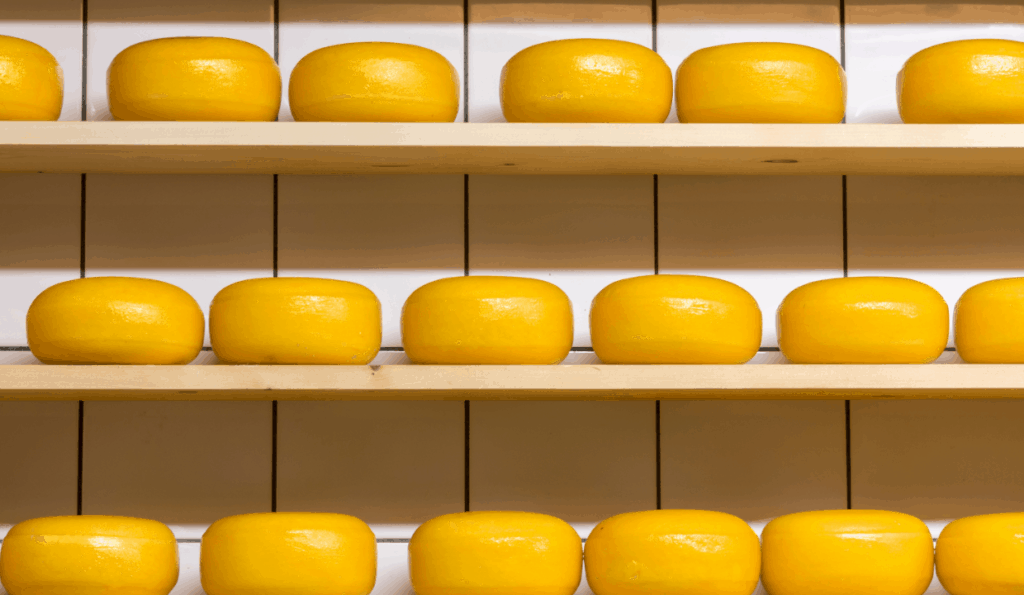
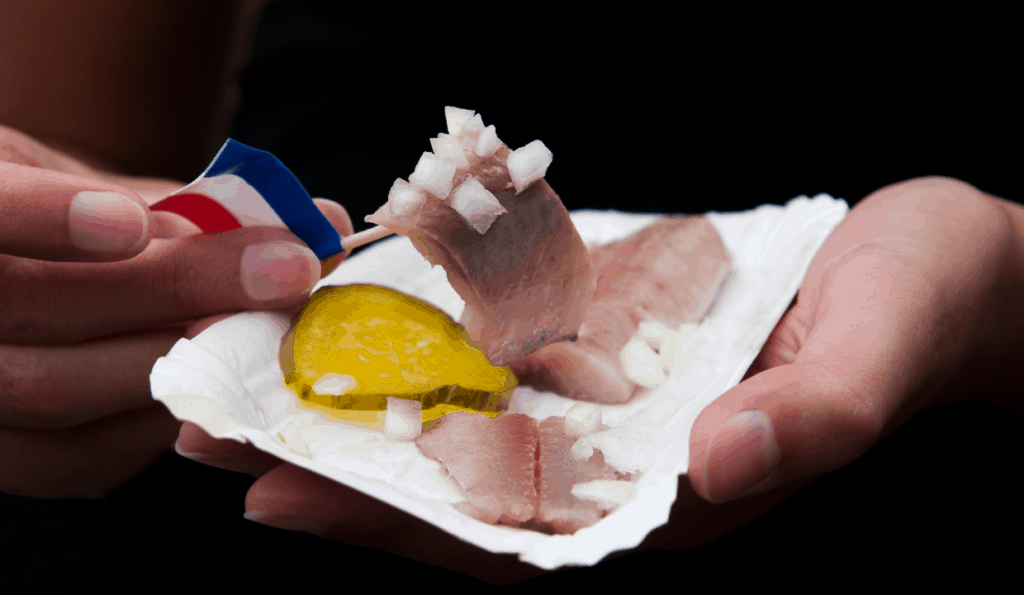
Francesinha, Porto Portugal
Recommended by Jorge Bastos, Portugal Things
Francesinha is the signature dish of our hometown Porto in Portugal. You’ll find this typical dish in other Portuguese cities but the place to have is in Porto, as that’s where the best Francesinhas are.
Francesinha is the ultimate decadent sandwich with toasted bread, ham, several types of sausages, steak, or roasted beef, covered with melted cheese and a hot thick tomato, beer, and peri-peri sauce. It is simply divine.
Although this dish is technically a sandwich you have to eat it with cutlery as it is covered with delicious melted cheese and hot sauce. Like in other dishes the secret of a good Francesinha is in the sauce and the quality of its ingredients. It is said that this extraordinary sandwich was created by a Portuguese emigrant that returned from France. He was inspired by the French croque-monsieur and created the Francesinha and its fantastic sauce.
There are several good restaurants in Porto to eat Francesinha but in our opinion, the best are Cafe Santiago, Lado B, Bufete Fase, or Cufra. Luckily for you, they are all easily accessible and close to the city center.
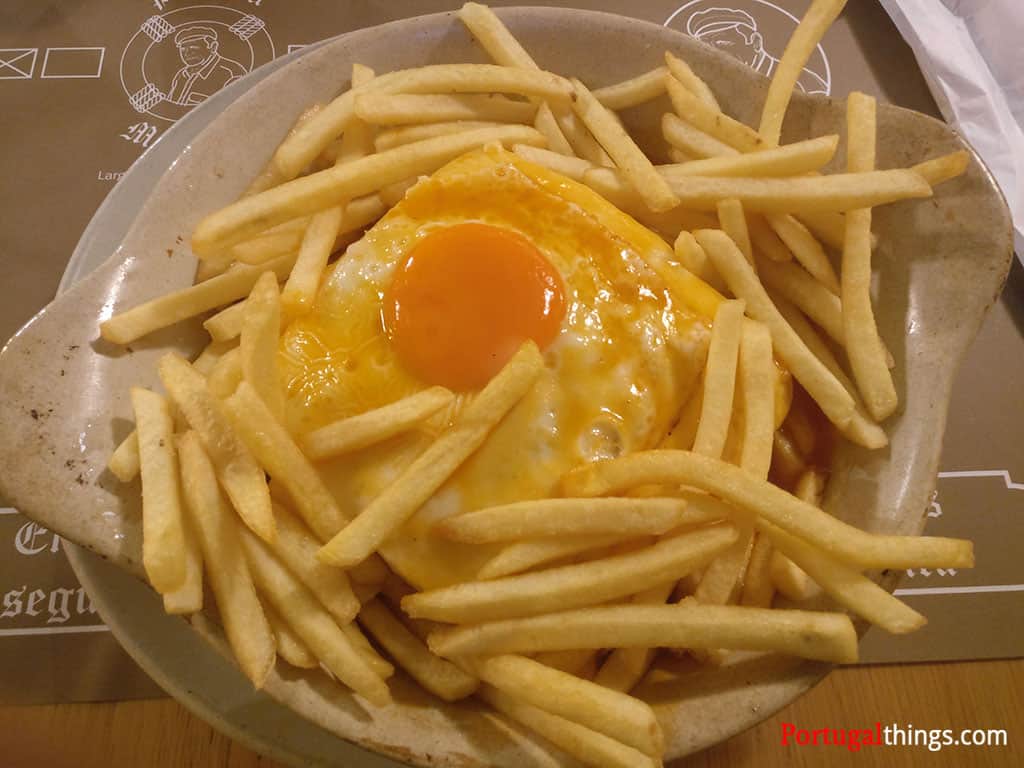
Fougasse, Provence, France
Recommended by Nadine Maffre of Le Long Weekend
Gazpacho, Andalusia, Spain
Recommended by Linn Haglund of Easy Way To Vegan
The most typical Andalusian summer dish is Gazpacho. Being a cold tomato soup, most foreigners find it strange, but once tasted, most people fall in love with the refreshing soup. Consisting of tomato, onion, garlic, green pepper, cucumber, salt, and pepper, it is popularly kept in the fridge of most Andalusian homes all summer. While most people drink it, you can get it served in a soup bowl in restaurants. It has also become more and more popular with Green Gazpacho, which can be made with different green vegetables like cucumber, green pepper, and avocado. Gazpacho is usually not served as a main, but rather an appetizer or, as mentioned, a drink. The refreshing, cooling dish is perfect in the hot Andalusian weather when you normally get less hungry, as it fills you up at the same time as it is not very heavy. If you look for good Gazpacho, make sure you ask if it is homemade, or “casera”, as they say in Spanish. Often, especially in more touristy areas, bars might serve ready made gazpacho which can be quite terrible, so make sure it is made there from scratch, so you do not ruin your first gazpacho experience. They usually serve it in most bars and restaurants over the summer months.
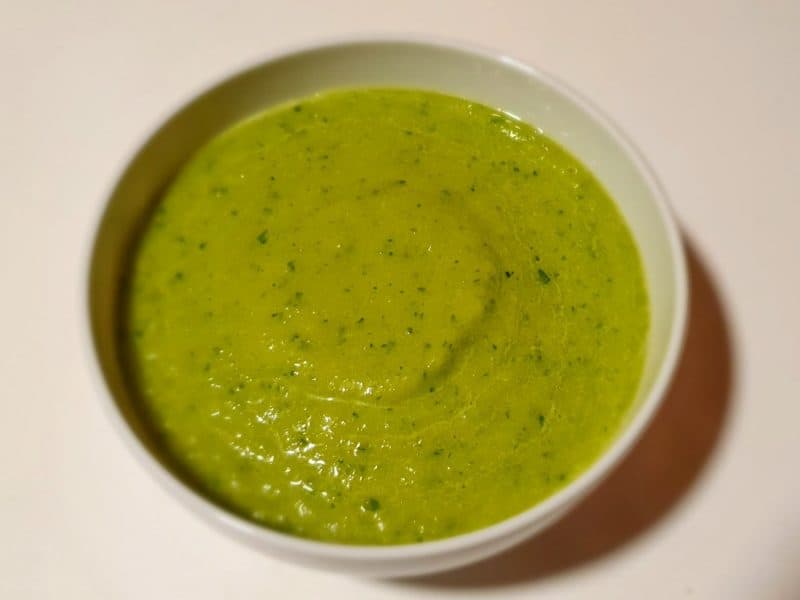
Handkase Mit Musik, Hesse Germany
Recommended by Megan Starrof MeganStarr
One of the most delicious local cuisines in Hesse, Germany is Handkäse mit Musik, which directly translates to ‘Hand Cheese with Music’. This cheese can be found everywhere from Frankfurt am Main to charming Rheingau Valley towns like Rudesheim.
Handkase mit Musik is a sour milk cheese that’s name comes from the way it was traditionally prepared by hand. It is unique and truly an acquired taste for most.
The cheese is translucent and a yellowish-white color. It has a strong odor and the taste is also rather strong, turning many away before they get to bite into it. It usually comes in the shape of a circle, but you can also sometimes find it square. Handkase can be served simply as ‘handkase’ or ‘handkase mit musik’ which means with onions. It usually also comes with caraway seeds on it and sits in a vinegar covered bowl or plate and is served with German bread alongside it.
You can find handkase mit musik at most traditional restaurants in Hesse state, but it is usually an appetizer, particularly served with another local delight, ‘Apfelwein’ (cider). If you are not wanting to sit at a crowded restaurant to enjoy, opt for the farmer’s markets in the region where you can almost always find it freshly prepared!
New Nordic Cuisine, Copenhagen
Recommended by Derek Harman of Everything Copenhagen
Denmark doesn’t have a reputation as a foodie destination, but the food scene of the country is one of Europe’s hidden gems. While the Danish people have a delicious national dish, a fun street food scene in most cities, and famous pastries – New Nordic cuisine in Copenhagen is its culinary crown jewel.
Copenhagen’s New Nordic movement emerged from the kitchen of Noma, rated the World’s Best Restaurant four times since 2010. The concept emerged as Scandinavian chefs met to formalize regional standards around the use of locally sourced ingredients and modern techniques applied to traditional recipes. For example, the Danish herb ramson replaces garlic in most recipes. Other local flavors like dill and ingredients like pickled root vegetables are the focus of New Nordic cuisine. Meats are commonly pork or duck and local fish like herring or salmon. The idea is to use only fresh and local products that are high in quality and capture the unique local flavor.
New Nordic meals are often served in a three or five-course menu with an optional pairing of wine of snaps (a Danish liquor). It’s only available as described on the menu, so customizing the dish is not an option. When in Copenhagen, a New Nordic meal is something every visitor should try.
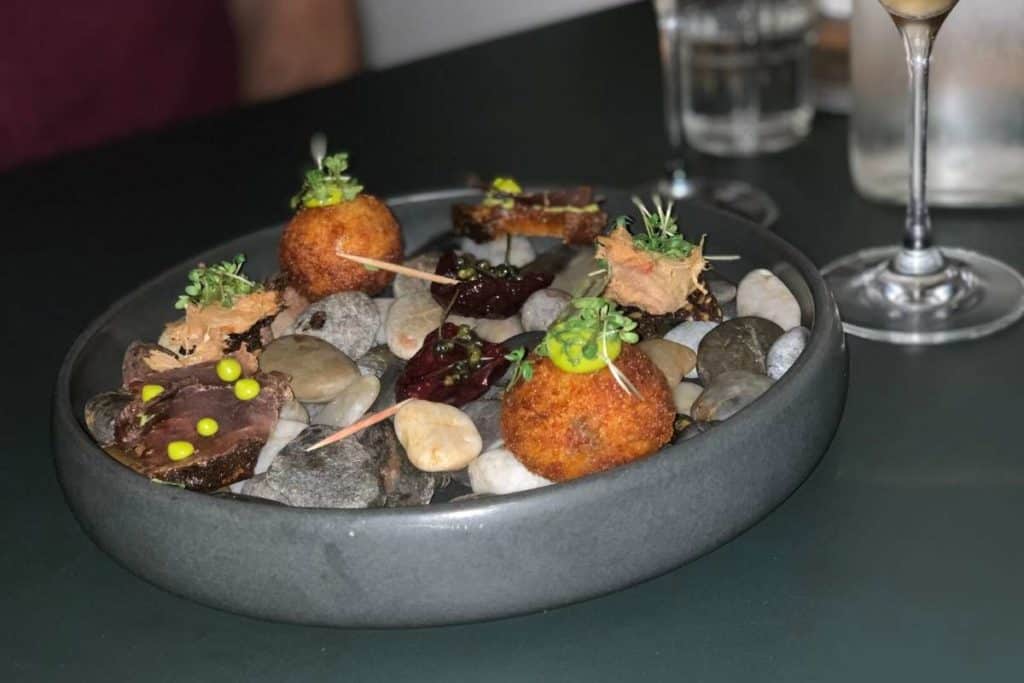
Broodje Kroket, The Netherlands
Recommended by Cosette from KarsTravels
The Dutch Broodje Kroket, or a kroket on a bun in English, is a thick cold ragout (usually beef or veal). The ragout is braided in egg wash, flour and bread crumbs, before being fried in oil. The kroket is served on a sliced white bun and topped with mustard (or mayonnaise). Broodje Kroket is one of the must try Dutch traditional foods.
The kroket originates in France, the first recipe is from 1705. The first Dutch recipe is dated 1830. At first it was served as a course in a larger meal, in the second part of the 20th Century it turned into a snack, which is served on a bun.
Best place to get this local cuisine is a broodje kroket is a snackbar, where they fry the kroket while you’re waiting.
A kroket is eaten on a bun, as is, with fries on a plate or with slices of bread and some salad.

Stroopwafel, The Netherlands
Recommended by Dymphe, Dymabroad
One treat that is unique for the Netherlands is stroopwafel. The literal translation is syrup waffle and it is delicious! It is a wafer cookie that consists of two thin layers with caramel in between them. Eating them cold is the most common way to eat them, but you can also eat a warm stroopwafel, which is even better. Stroopwafels were created in the Dutch city of Gouda in the 18th century. Around 1870 they started to spread to other cities in the Netherlands. Today you can buy them in every supermarket and at markets in the Netherlands. The best place to eat them is at the Albert Cuyp Market in Amsterdam, as you can get warm ones there. Even if you would be only one day in Amsterdam, you should definitely go there! Another great place to get a stroopwafel is at van Wonderen Stroopwafels in the city center of Amsterdam.

Egg Waffle, Hong Kong
Recommended by Nam Cheah, Laugh Travel Eat
Egg Waffle, also known as eggettes, egg puff, or bubble waffle, is a street food that originated from Hong Kong. While many would compare it to Belgian Waffle, the inception of the egg waffle comes from the streets of Hong Kong. Created by an entrepreneurial vendor in the 50s, it was born from the need to use broken eggs and a unique iron cast. The original flavour is to eat it plain, as you would find in many street corner street food vendors, but in the recent decade various other flavours have popped up. Some are wildly popular like chocolate and matcha. Some are a lot more adventurous like meat floss, borscht, and cheese.
I have many favourite places for egg waffles but most of them are in Mong Kok, the busy heart of Kowloon where you can find many other street foods. The best egg waffle is crunchy on the outside, with an air pocket and a chewy, light middle.
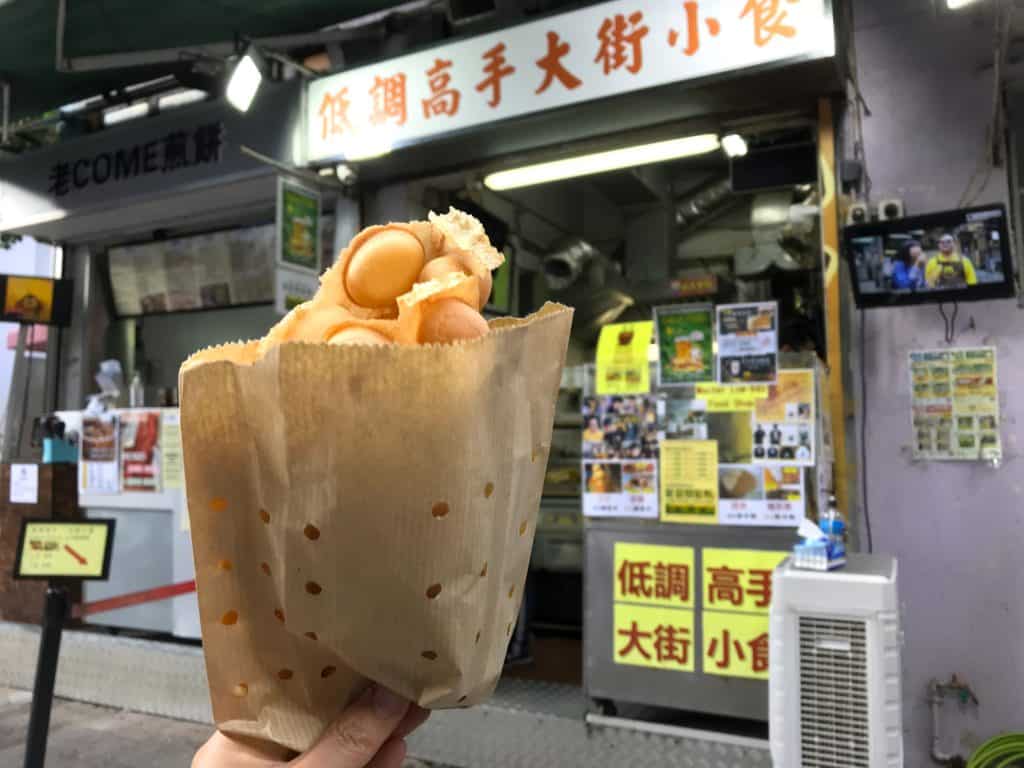
Khash, Armenia
One of the most interesting and unique dishes coming from Armenia is an ancient dish called Khash. It is not just a food but it is also a total ceremony and you need to follow the unwritten ‘khash’ rules.
Khash was originally the local cuisine for poor people and commoners at the beginning because the ingredients used to be considered to be “leftovers”.
After the wealthier people took all of the good cuts of meat from the cow, the poorer folks found a way to use the cow legs that were leftover so they decided to boil them for a long time into a ‘soup’ of sorts. The word ‘khash’ actually means ‘boil’. Khash is cooked for many hours (approximately 5 hours or more) on a fire and you don’t add any other things to it… you just wait for the flavors to come out.
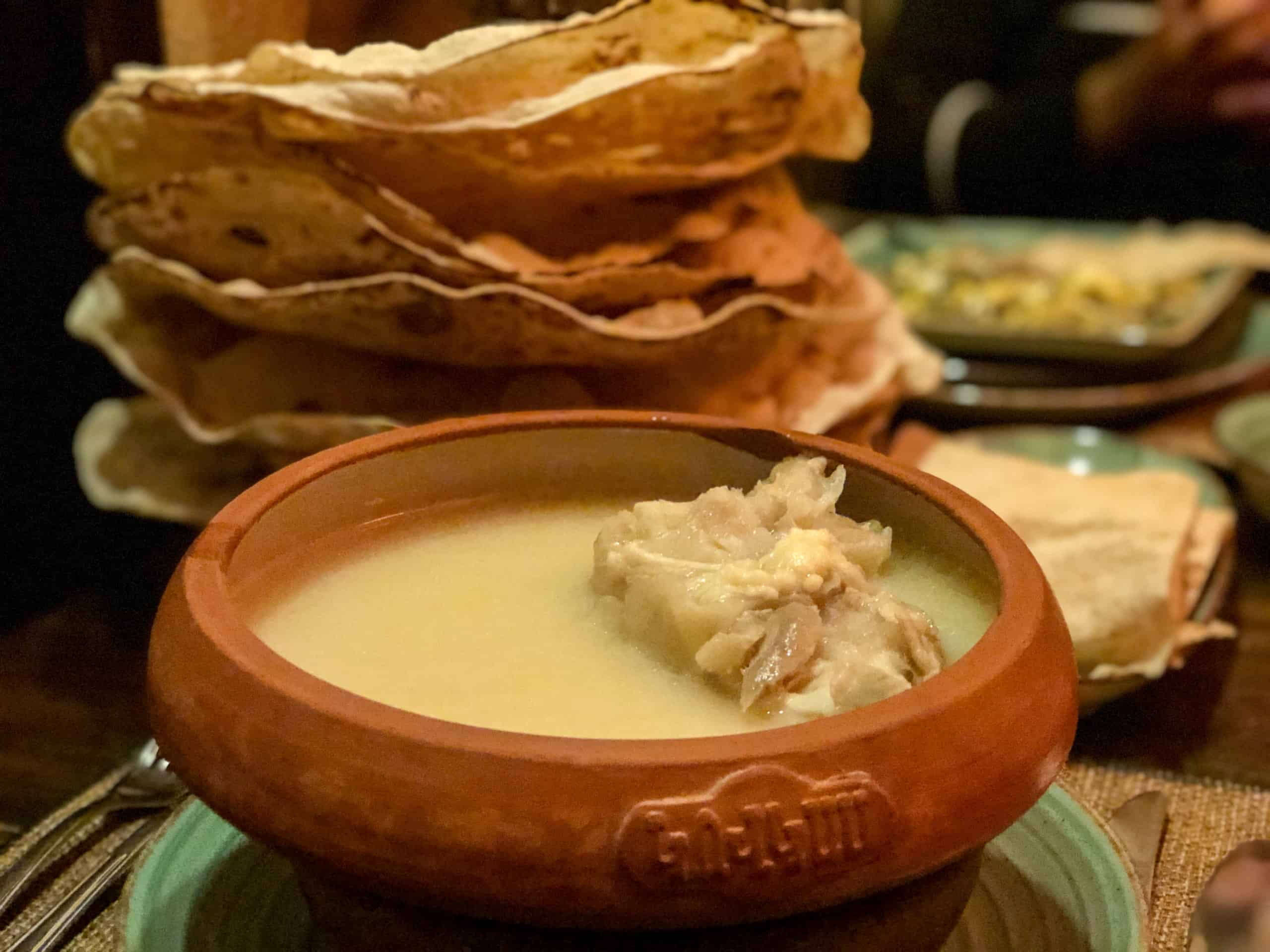
Rosogolla, Kolkata India
Recommended by Ruma Dey Baidya , The Holiday Story
Be it on weddings, birthdays, or just an ordinary day, a Bengali’s meal remains incomplete without a dessert. Amongst all the sweet dishes, the all-time favourite is the irresistible Rosogollas. The craving for Rosogolla remains constant for both the young and old, health-conscious, and health-ignorant.
Rosogolla’s existence can be traced back to 1868. The white-coloured sugary balls were an accidental creation of Kolkata’s then-famous sweet-maker, Nabin Chandra Das. Just like some experiments lead to miraculous inventions, Rosogollas were the same. The overwhelming popularity and demand even outside of Bengal made Krishna Chandra Das introduce “canned rosogollas”. These could easily be shipped far and wide without getting stale.
Every year, you will find the white rosogollas undergoing seasonal yet flavourful changes. Winters call for Nolen Gurer Rosogolla (jaggery-infused) and Aam Rosogolla (mango flavoured) in summers. Amongst the 250 variants, Baked Rosogolla is another delicious variant in Kolkata.
This oh-so-lovely sweet is prepared by rolling out dried cheese (chhena) into balls, obtained from fermented milk. Dipped and boiled in hot sugar syrup till it fluffs up. West Bengal’s patent Rosogolla is now a global hit among the sweet-lovers. But you can try it from these authentic shops in Kolkata: Nabin Chandra Das & Sons, K.C. Das, Chittaranjan Mishtanna Bhandar, Balaram Mullick & Radharaman Mullick Sweets.
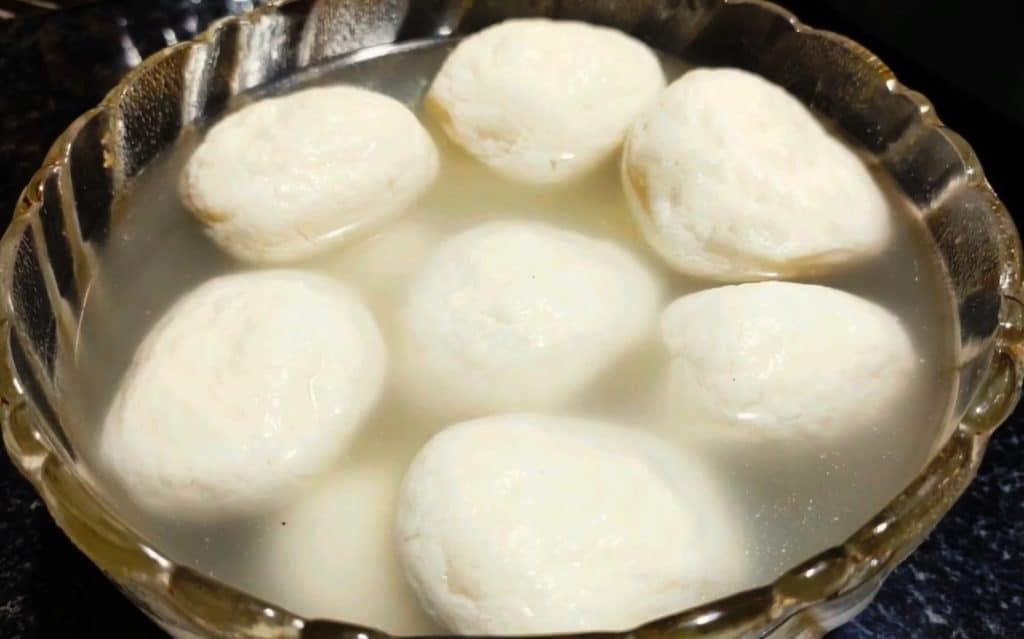
Dhokla, Gujarat India
Recommended by Mayuri Patel of Fernwehrahee
India is not only famous for its Palaces, forts, culture, and architecture, but for its best food too. India has a diverse culture and the food habits are different in every region. North Indian and South Indian local cuisines are completely different. I live in western India in the state of Gujarat. It shares a border with Rajasthan, Maharashtra, and Madhya Pradesh. It is connected to Pakistan Border in western most part. The state has a rich history in terms of cuisines, and it’s famous for gram flour-based items like- fafda, jalebi, ganthiya, khaman, and dhokla. You can see lots of streets throughout the state where you will find all these snack-based items.
The Dhokla is a spongy steamed cake made with rice flour and lentils. It is basically made with chana dal and rice. The Lentils and rice soaked throughout the night. The next day it is crushed in Mixer and fermented for 7-8 hours. Then it is steamed in a big dish and served hot with coriander chutney.
Dhokla is not only popular in Gujarat but outside Gujarat too! You can find many shops selling Dhokla in the UK, Europe, and the USA.
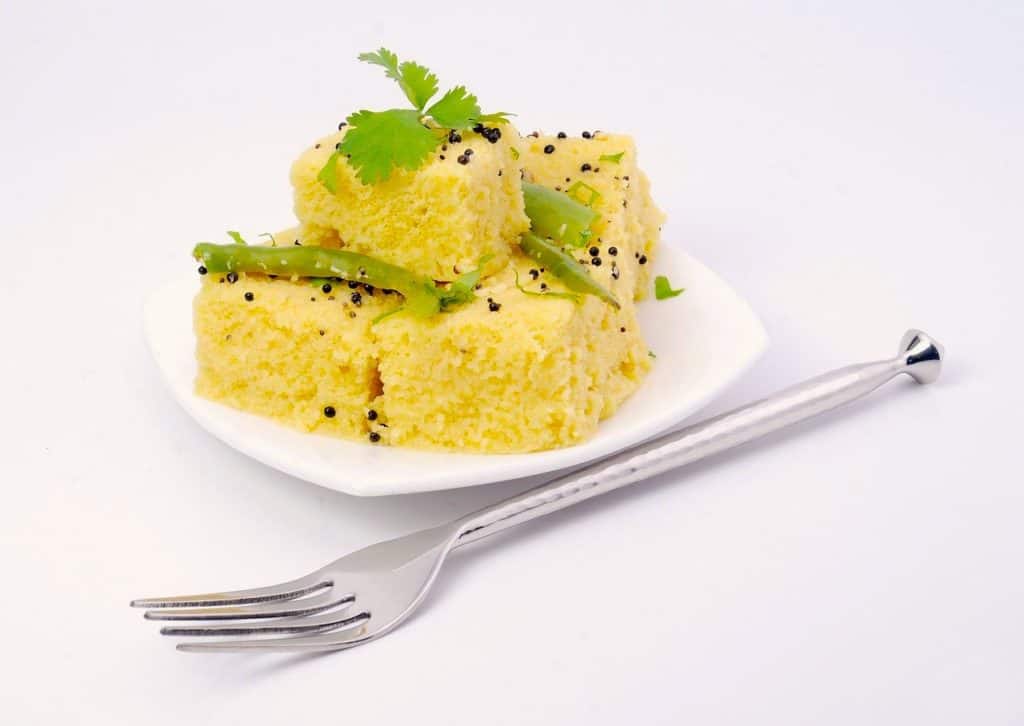
Ghewar, Sarkarshahr India
Recommended by Jyoti Baid of Story at Every Corner
Ghewar from the little town of Sardarshahr near Bikaner, Rajasthan in India, is the best! Probably the best in the world. It’s a delicacy dessert that’s served on special occasions like wedding and festivals. It’s essentially a disk of honey comb like structure except it’s not made by bees.
The ingredients are no secret. They are the regular fried batter and sugar. The secret is in the long process. The batter is prepared and left to rise a while. Then it’s poured in very small amount into circular mold placed in boiling oil. As soon as the batter hits the oil it splatters and sticks to the mold. One layer at a time , the splatter forms a honeycomb structure. So the technique is in the texture, quantity and timing of the batter. The crispy perfection that melts into you mouth is what you look for. One can pour sugar syrup, whipped cream and condiments on the disk to make it special.
One has to eat ghewar to believe it. The best ones can only be found in the small town of Sardarshahr but you can also find them in bigger towns like Jaisalmer with its large Jain influence.
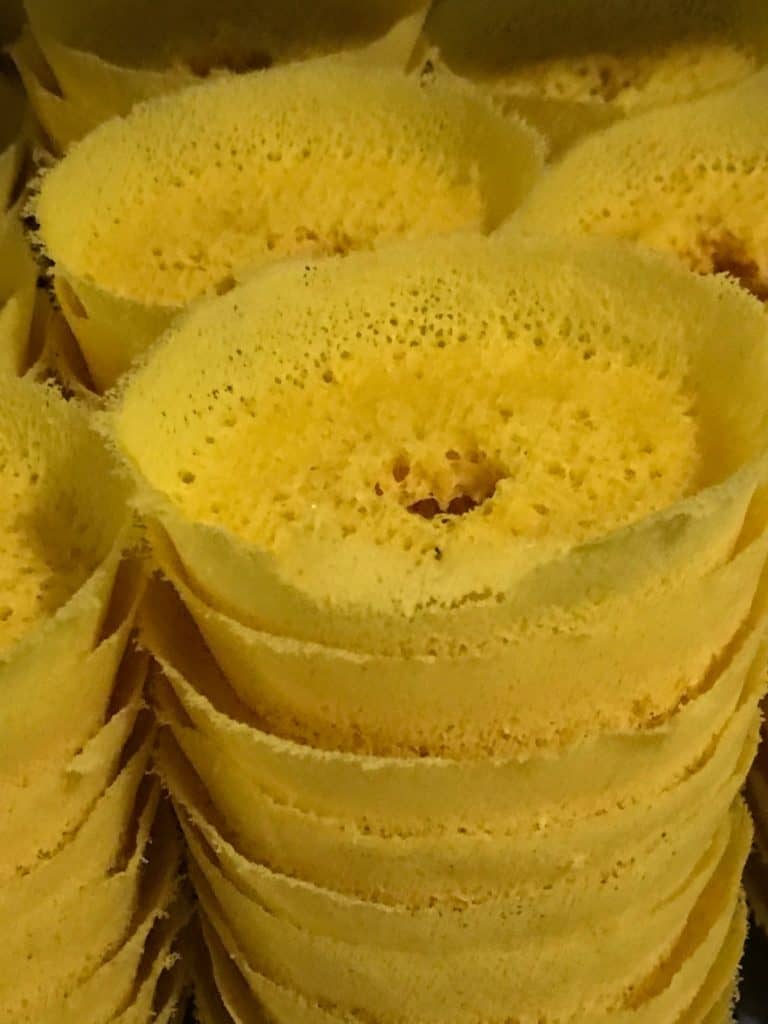

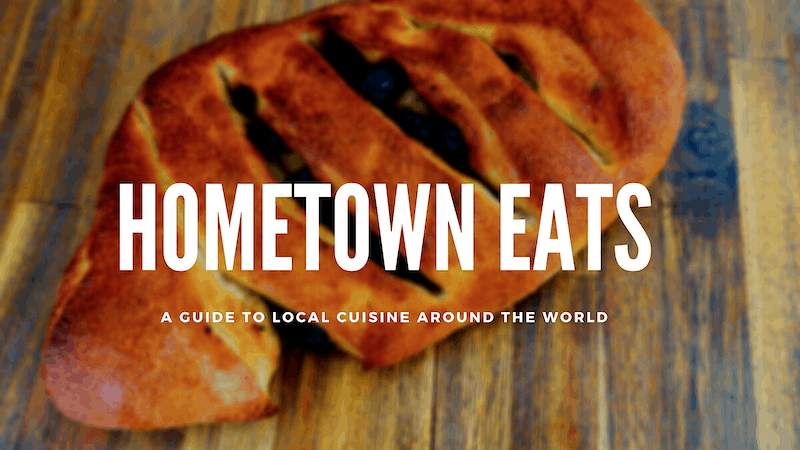
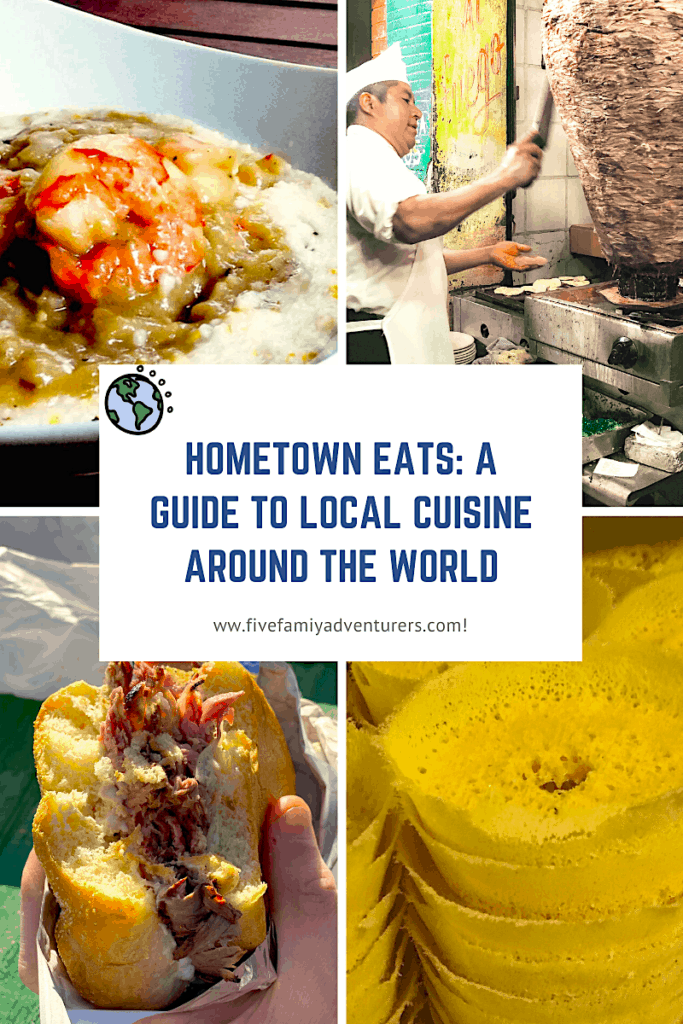
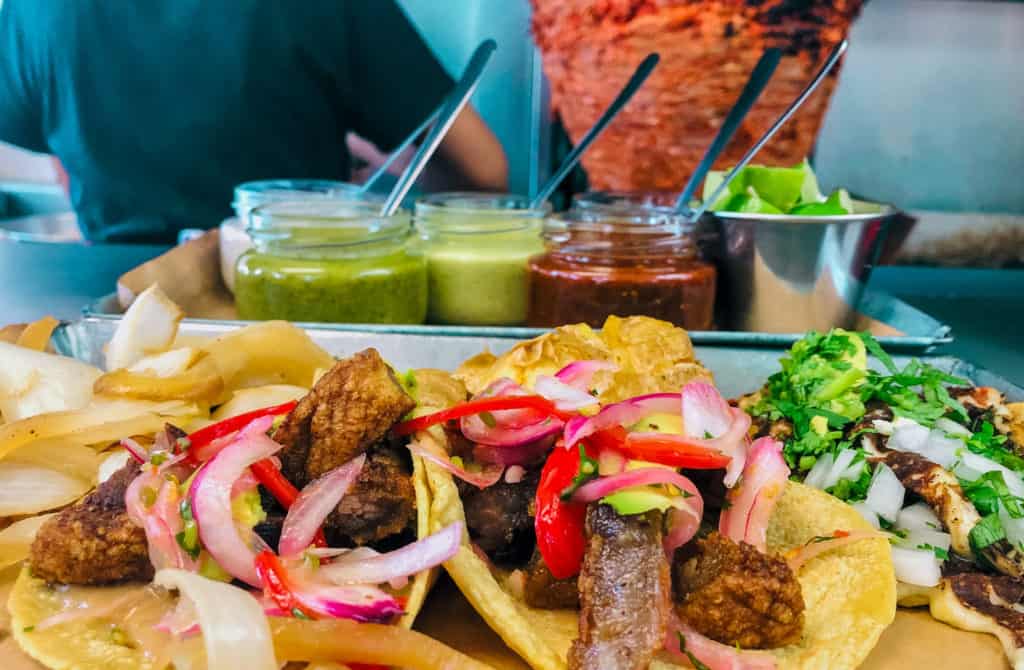
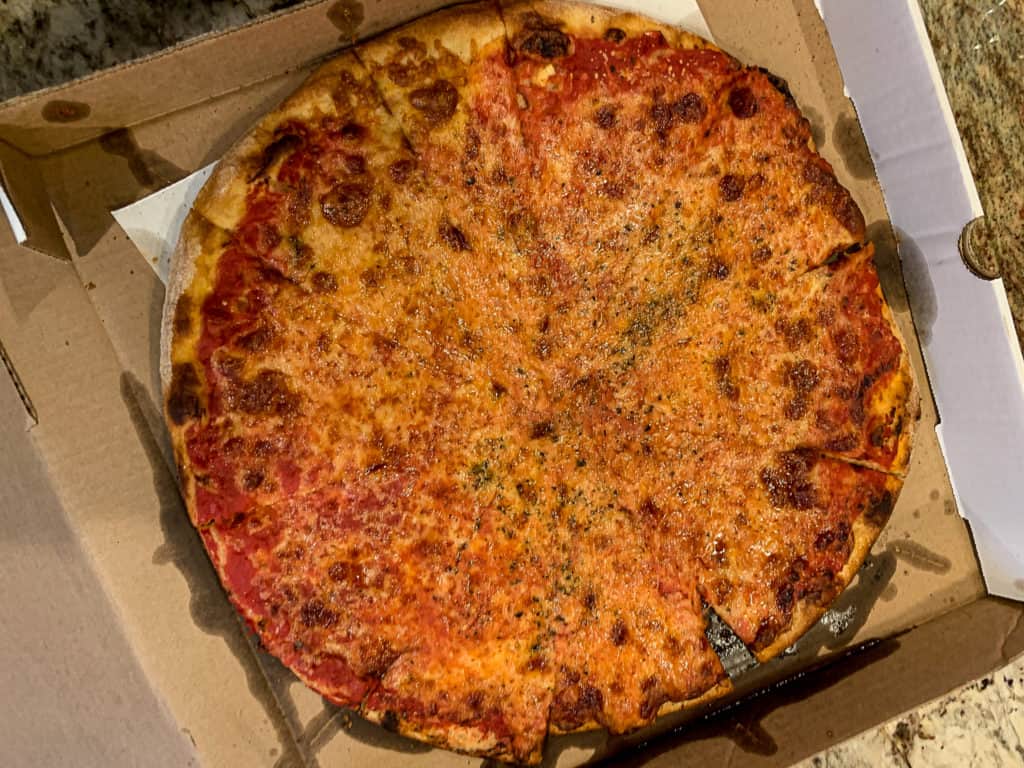
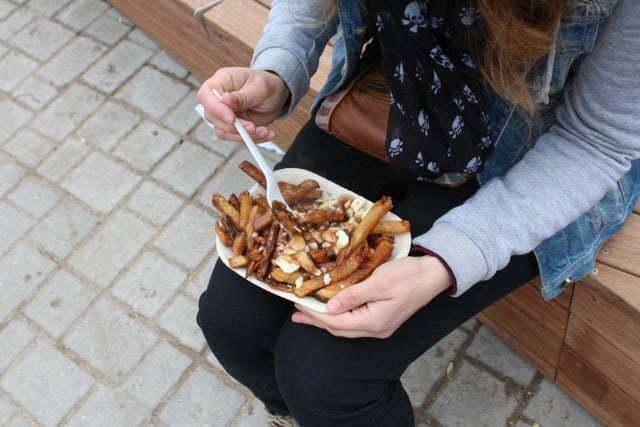
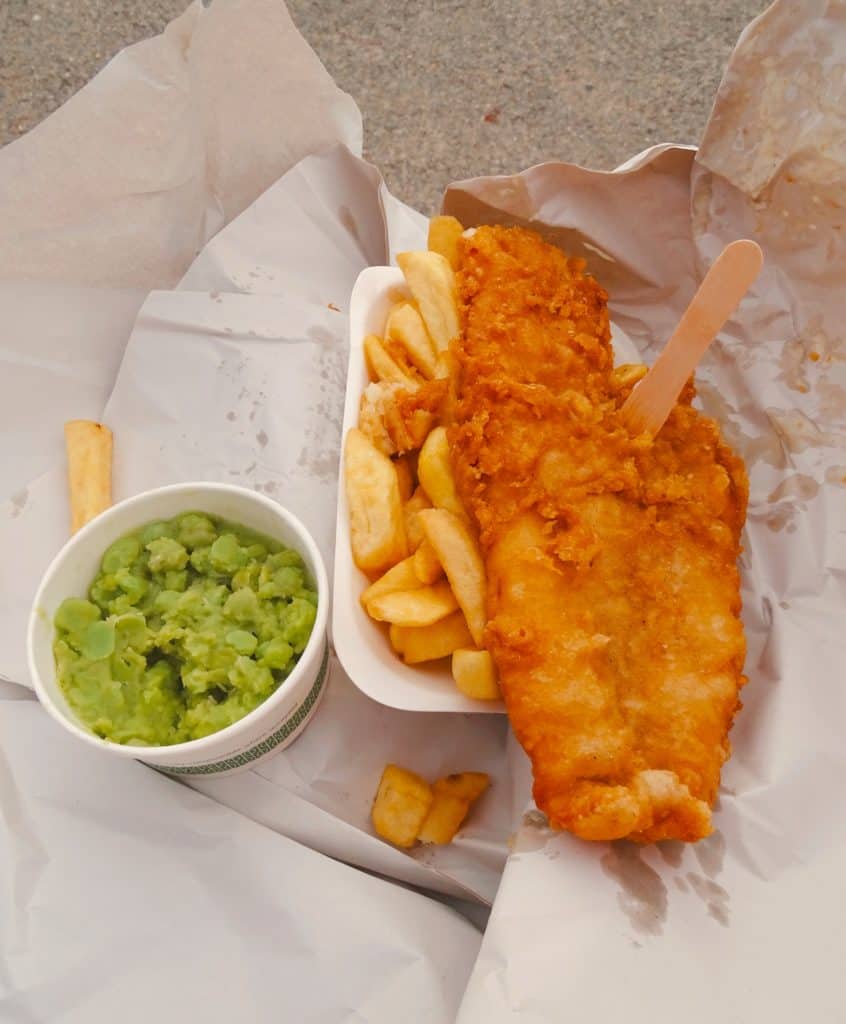
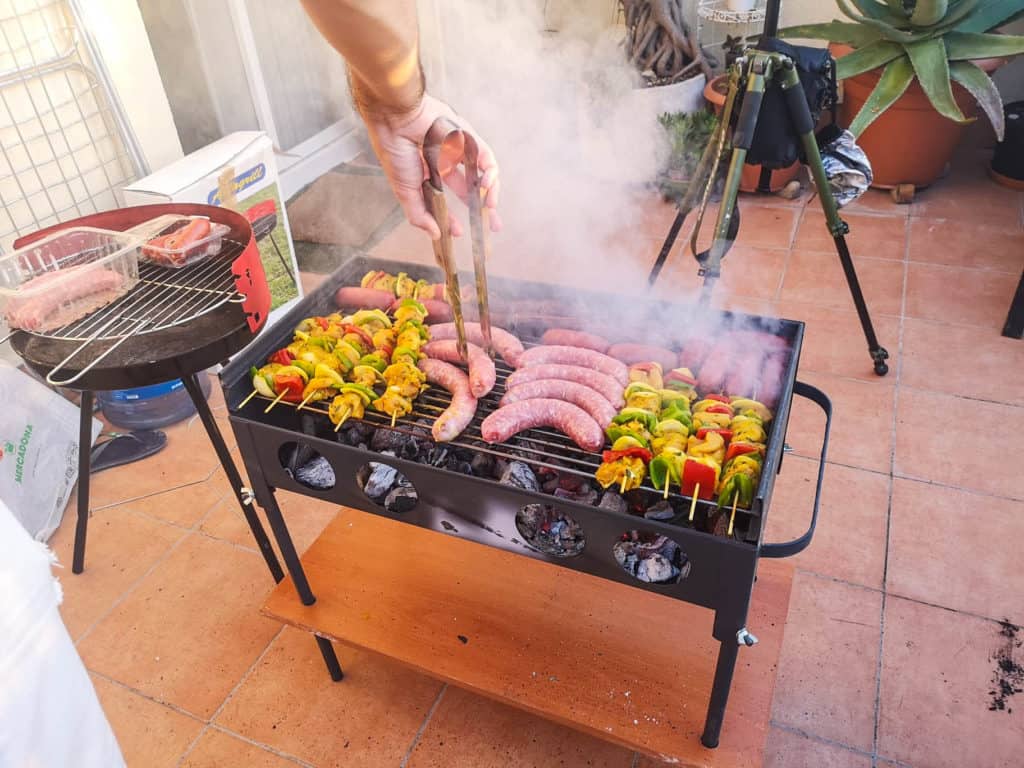
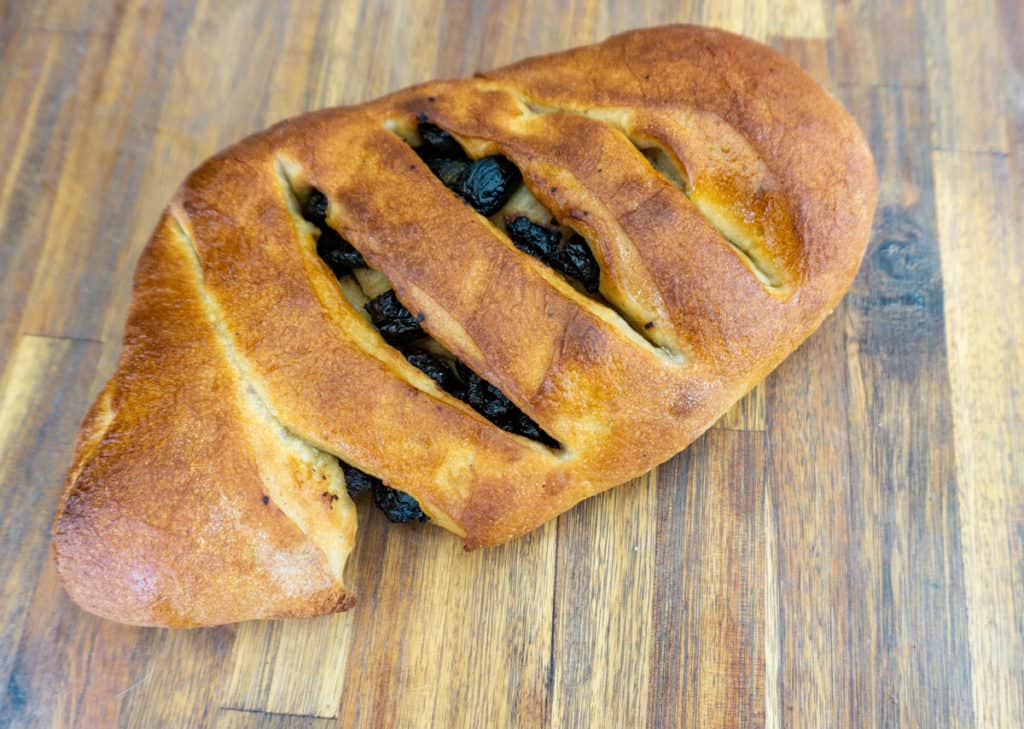
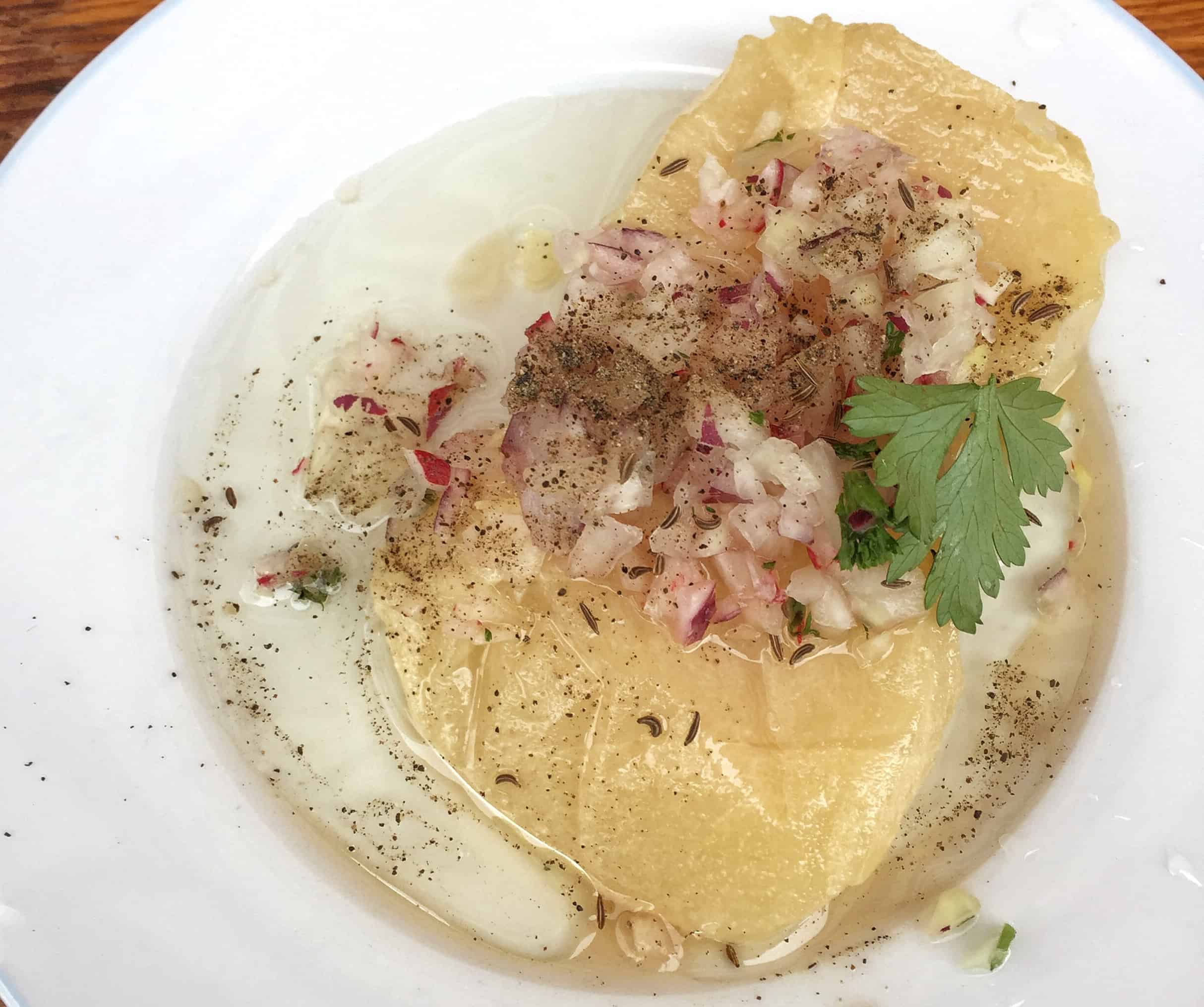
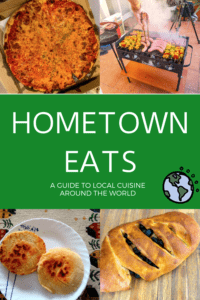
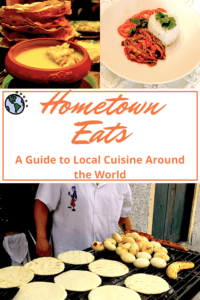
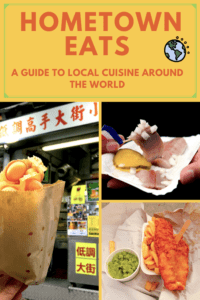



 The Essential Disney Day Park Must-Haves
The Essential Disney Day Park Must-Haves








I love foodie “best of” lists, this is great! I hope to be be able to try a few of these on my travels ☺️
Travel and food are a perfect match. Thank you😊
This makes me want to travel! All of this food looks super yummy, especially the tacos del pastor 😋
So many amazing meals to eat around the world!! Now I am hungry!
This is so awesome! I love the diversity of your foodie list. I am saving this one for later so I can look for them.
I wish I could eat all of this! I want to eat around the world!
This Foodie list is amazing! Im starving all of a sudden! One of the draws of travel, for our family anyway, has always been trying the local cuisine. I have to admit, Im German, and have never heard of handkase before! Interesting!
I love discovering local foods in my country as well. Gumbo was a favorite discovery in New Orleans for me.
I love this guide. One of the most important things to do when traveling to a new location is to try the local food!
Couldn’t agree more
Love this foodie guide at all the local cuisine around the world! Everything looks sooooo good!
This all looks absolutely amazing! I love exploring international foods!